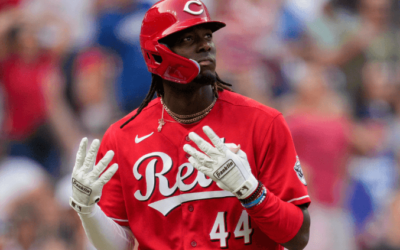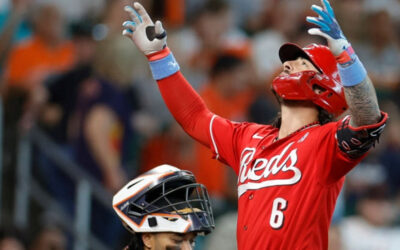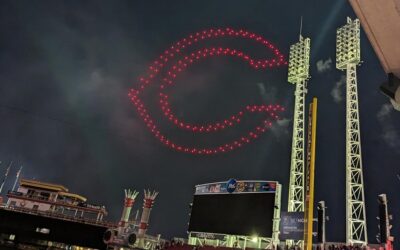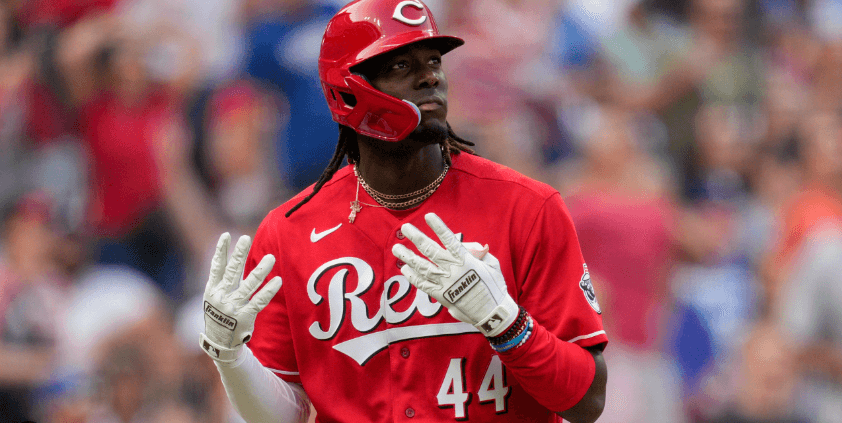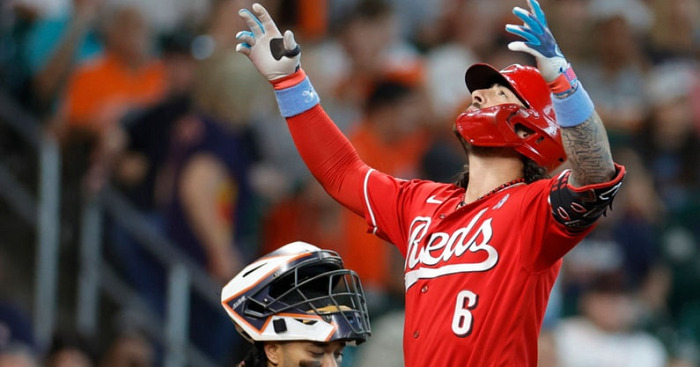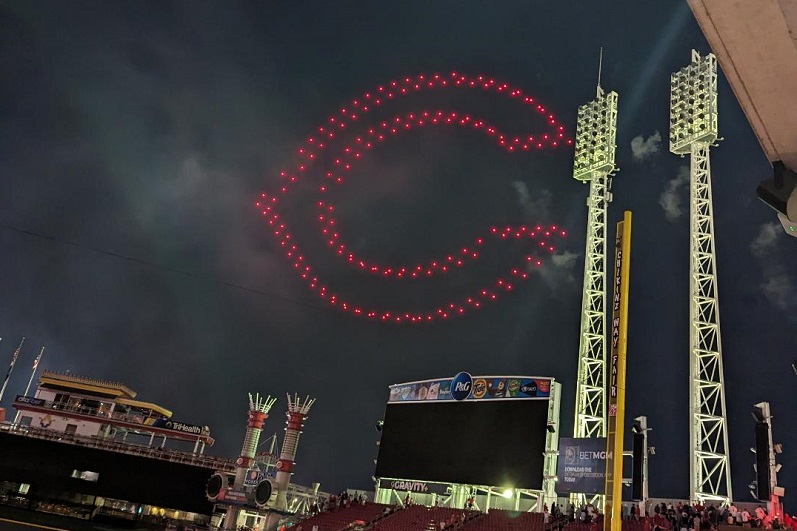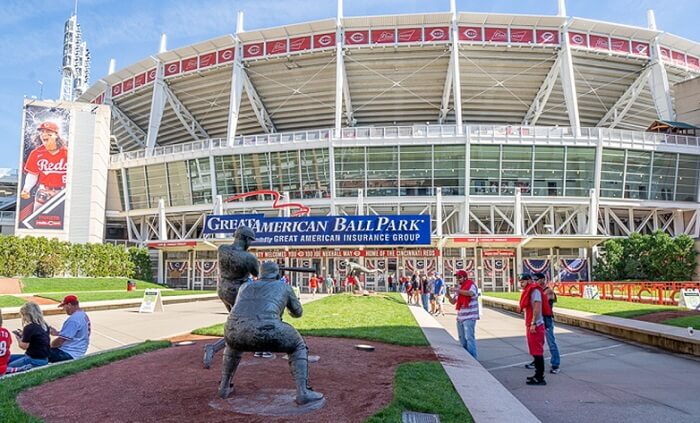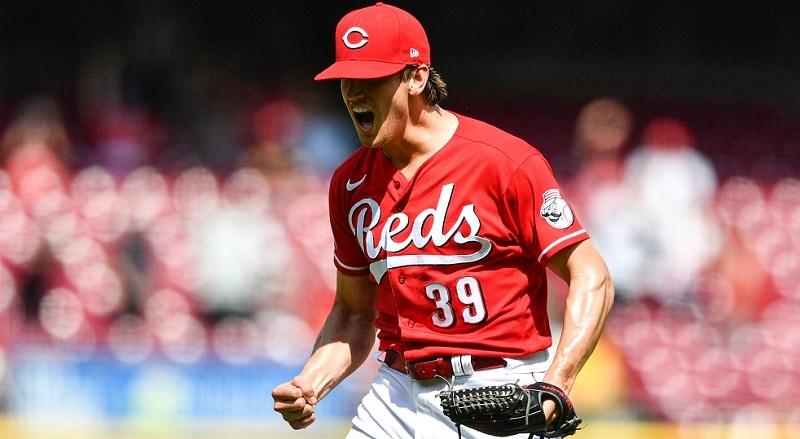Trending in Baseball
The First Place Reds and an Interview with Ickey Woods
Reds First...
Cincinnati Reds in June Updates and News
The...
Cincinnati Reds News and Agreement with Griffey Jr
Cincinnati...
Best Baseball Betting Offers
Best Overall Sportsbook
Bet $1, Get $200
When You Bet on Baseball
Best Daily Fantasy Baseball
100% Bonus up to $100
Use Promo Code: THEUSG
Best Odds and Markets
Get a $500 RIsk-Free 1st Bet
Use Promo Code: THEUSG
How To Bet Baseball
Unlike other popular sports, most wagers placed on MLB games do not involve a point spread. Instead, bettors typically wager on the moneyline, looking to predict the winner of the game straight-up.
The less-popular cousin of the moneyline bet in baseball is the runline wager. The betting favorite will be assigned a -1.5-run handicap, but oddsmakers will offer an appropriate amount of “juice” to make laying the 1.5 runs with the favorite more appealing.
Totals wagers in baseball work very much like totals wagers in other sports. Oddsmakers will assign an Over/Under figure to every game, leaving bettors to determine whether the game in question will be a home run derby or a pitcher’s duel. Totals of 8.5 runs are typical of MLB games, though totals as low as seven runs and as high as 10 runs will pop up throughout the season.
MLB Positions by Number and 2022 Odds
Have you ever looked at a baseball score card and wondered what all the numbers meant? I’m sure you’ve heard an announcer talk about a 6-4-3 double play. They are actually referring to baseball positions by number instead of by the players name. On a score card, it’s much easier for the scorer to write in the designated numbers, especially when there can be several substitutions over the course of the game.
We’ve broken down the baseball positions by number, listed our top 3 players at each spot, and given you the odds for MVP/CY Young.
Position 1: Pitcher
The pitcher sets the tone on the defensive side of the game. Their job is to make it as deep into the game as possible. By definition, a quality start is 6 innings pitched and giving up 3 or less runs. In today’s game, where pitchers are given rather short leashes, anything over 7 innings and 3 or less runs is a great outing.
1. Sandy Alcantara, MIA (-210)
2. Justin Verlander, HOU (+155)
3. Shane McClanahan, TB (+210)
Position 2: Catcher
Also known as the backstop, the catcher is arguably the toughest position to play on the field. They are usually in charge of calling pitches and relaying them to the pitcher. In addition, they will alert the infield on where to play depending on the situation.
1. Will Smith (LAD)
2. Wilson Contreras (CHC)
3. Alejandro Kirk (TOR)
Position 3: First Base
First base is one of two corner positions in the infielder. Not only are they responsible for fielding ground balls like any other infield position, they also are in charge of catching throws from other players for the force out at first base. They sport a special glove that assist in ‘digging’ balls that are thrown low and skip before reaching the glove.
1. Paul Goldschmidt, STL (-125)
2. Freddie Freeman, LAD (+700)
3. Pete Alonso, NYM (+1800)
Position 4: Second Base
Position in between the shortstop and first basemen, the second basemen is the slightly less talented of the middle infielders. Not putting them down by stating they’re less talented than a shortstop, but they generally have just a little less range.
1. Jose Altuve, HOU
2. Jeff McNeil, LAD
3. Andres Gimenez, CLE
Position 5: Third Base
Famously known as the hot corner, the third baseman usually fields the hardest hit balls out of all infielders. It’s a tough place to play and are known for having the strongest arms out of all infielders.
1. Nolan Arenado, STL (+3000)
2. Jose Ramirez, CLE (+6000)
3. Manny Machado, SD (+2500)
Position 6: Shortstop
This position is the most important of all infielders, minus catcher. They are responsible for fielding the most batted balls of any other position. It requires the most range (meaning covering the most ground) out of all positions and the arm strength of a third basemen.
1. Trea Turner, LAD (+2500)
2. Xander Bogaerts, BOS (+20000)
3. Francisco Lindor, NYM (+4800)
Position 7: Left fielder
Left field is the first position by number in the outfield, and 10-15 years ago, they were the ‘second best’ outfielder, but now, they are the least athletic. They can be found behind the third baseman and shortstop and typically put up great offensive numbers but are the biggest defensive liabilities.
1. Andrew Benintendi, NYY
2. Kyle Schwarber, PHI
3. Ian Happ, CHC
Position 8: Center fielder
The premier position in the outfield, they are typically the best defenders. They cover the most ground between the 3 players in the outfield and are known for their acrobatic diving plays.
1. Mike Trout, LAA (+25000)
2. Julio Rodriguez, SEA (+25000)
3. Byron Buxton, MIN (+25000)
Position 9: Right fielder
The last corner outfielder of them all, the right fielder is one who is a bit better on defense than LF, but not as good with the glove as the outfielder. They are the second most important outfield position and usually have the strongest arm out of all 3.
1. Aaron Judge, NYY (-420)
2. Mookie Betts, LAD (+1800)
3. Yordan Alvarez, HOU (+5000)
Not included in position by number are designated hitters. They are typically defensive liabilities or injury prone and only hit. This is especially an important position since the designated hitter is now a universal pitcher in the American and National leagues.
1. Shohei Ohtani, LAA
2. Bryce Harper, PHI
3. JD Martinez, BOS
MLB AL MVP Odds
| Odds to Win AL MVP | Fanduel | Draftkings | Betfred |
| Aaron Judge | -420 | -400 | -425 |
| Shohei Ohtani | +350 | +330 | +350 |
| Yordan Alvarez | +5000 | +4500 | +5000 |
| Jose Ramirez | +6000 | +6500 | +6000 |
| Rafael Devers | +10000 | +10000 | +10000 |
| Vladimir Guerrero Jr. | +10000 | +10000 | +10000 |
| Jose Altuve | +20000 | +10000 | +20000 |
| Tim Anderson | +20000 | +10000 | +20000 |
| Xander Bogaerts | +20000 | +10000 | +20000 |
| Anthony Rizzo | +25000 | +10000 |
+25000 |
MLB NL MVP Odds
| Odds to Win NL MVP | Fanduel | Draftkings | Betfred |
| Paul Goldschmidt | -140 | -140 | -135 |
| Austin Riley | +600 | +425 | +400 |
| Freddie Freeman | +750 | +700 | +700 |
| Pete Alonso | +1200 | +1500 | +2000 |
| Nolan Arenado | +2000 | +2500 | +3000 |
| Mookie Betts | +2000 | +2000 | +1800 |
| Trea Turner | +2500 | +2500 | +2000 |
| Manny Machado | +2500 | +2500 | +2500 |
| Juan Soto | +3500 | +3500 | +3500 |
| Francisco Lindor | +7000 | +7000 | +4500 |

About Baseball
How is Baseball Scored?
Anyone who has been to an MLB baseball game may have noticed after every play the scoreboard will say something like “score that play…” and then give a series of numbers and/or letters. You rarely see fans carrying around large scoring cards anymore but for some, they may be wondering still how does scoring work in baseball.
Positions
On the field defensively, there are always 9 players. Each player gets a number assigned to them based on position (and original position if there is some sort of shift for certain hitters). They are assigned as below:
- Pitcher
- Catcher
- First baseman
- Second baseman
- Third baseman
- Shortstop
- Left fielder
- Center fielder
- Right fielder
Possible Basic Defensive Plays
A hitter making a single out can either strikeout, line out, groundout, or fly out. When a batter strikes out that is marked with the letter “K”; if he strikes out looks usually the “K” is written backwards. A lineout is sometimes maker with an “L” then the position, so a hitter who hits a line drive caught by the first baseman would be scored “L3”. Similarly, a flyout in the outfield can be marked with an “F” where “F9” would be a flyout to the right fielder. Groundouts are noted with just the numbers of who made the play, so a groundout where the shortstop threw the batter out at first would be “63”.
Other Defensive Plays
There can be some other defensive plays, such as double plays, errors, or a fielder’s choice. In a double play, scoring usually uses the numbers in a similar fashion to a ground out. For example, a grounder to the shortstop who flips the ball to second base where the second baseman throws to first would be a 643 double play (sometimes the scoring will say “DP” other times it is just noted at “643”). An error is noted with an “E” before the fielder who made the error, such as “E6” or “E3”. A fielder’s choice, when the hitter does not get thrown out at first base but another baserunner does get thrown out, is usually noted with “FC”. This still does not count as a hit for the batter because the scoring shows that if there was no one on base the hitter would likely have been thrown out. This somewhat normalizes all averages across the league, although something like a baserunning mistake could take a hit away from a teammate.
If the Batter Gets on Base
There are lots of other scoring possibilities when an out is not made. The basic ones are hits, where a hitter can hit a single “1B”, a double “2B”, a triple “3B” or a homerun “HR”. Occasionally with a hit the scorer also draws a line on the diamond given on a score sheet for where the hit went, but that is not given in most stadiums when us fans see the scoring billboard. A batter can also reach without a hit on an error, which was shown above, or on a walk. If the walk was due to 4 balls being pitched, it is marked “BB” (base on balls), if the walk is intentional it is noted “IBB”, and if the batter gets hit by a pitch the scoring would be “HBP”. Finally, fans will notice when they look at a score sheet sometimes the diamond is colored in partially or fully. A scorer using a score sheet will also denote how far that player reached in the inning after getting on base by shading in the lines on the diamond or coloring in the whole diamond, which would mean he scored a run.
Other Less Common Scoring
There are of course other plays you may not see every game that will flash on the scoring sign at the stadium. If a runner steals a base successfully that is marked “SB” and if he is thrown out “CS” for “caught stealing”. If a pitcher balks with runners on base, they move up one base because of it and the score sheet would note that with a “B”. There can also be a pitch that gets by the catcher, and thus the runners move up because of it but they do not get credit for a steal. If the pitch is deemed wildly thrown by the pitcher it is a wild pitch “WP” and if the catcher should have caught it, but didn’t, it is a pass ball “PB”. Finally, there can occasionally be interference, when a runner collides with a defensive player, or the ball in play, which throws off the play. This is noted with an “I” and the runner is automatically out, or “DI” if a defensive player not involved in the play collides, making the runner automatically safe at the next base.

